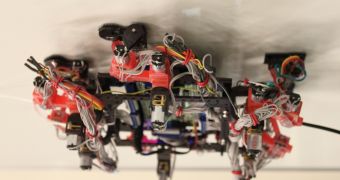Officials with the European Space Agency announce the development of a robot that mimics the behavior and capabilities of a gecko for moving around on surfaces that are inaccessible to other robots, or even humans. The machine can easily climb up a smooth vertical wall.
This ability stems for the unique design that researchers have used for the soles of its six feet. The pattern they have created is an accurate replica of that found on the feet of gecko, creatures renowned for their ability to run on water and stick to glass, even when upside-down.
In the same study, the ESA team was able to demonstrate that the robot is capable of functioning in low gravity or microgravity as well, meaning that it can potentially be used aboard the International Space Station, or on other spacecraft.
Once this technology is perfected, the team behind the project says, it may be possible to envision spacecraft featuring robotic attendants, capable of fixing any damages that might occur during a long travel. Such robots could be used on both manned and unmanned missions, the group says.
The machine was developed by ESA scientists, who worked closely with colleagues from the Simon Fraser University, in Canada. The key to their success was a dry adhesive substance inspired by geckos, which was demonstrated in the new study to retain its properties even when exposed to conditions mimicking the harshness of outer space.
Abigaille crawling robots were used for these experiments. “This approach is an example of ‘biomimicry’, taking engineering solutions from the natural world,” SFU researcher Michael Henrey explains. Geckos are able to adhere to nearly every surface due to little hairs on the soles of their feet.
These hairs are just 100 to 200 nanometers across and this small size enables them to interact and intermingle with all types of surfaces nearly at an atomic level. This is why a gecko can travel on a piece of smooth glass upside-down, without falling.
“We’ve borrowed techniques from the microelectronics industry to make our own footpad terminators. Technical limitations mean these are around 100 times larger than a gecko’s hairs, but they are sufficient to support our robot’s weight,” Henrey concludes.

 14 DAY TRIAL //
14 DAY TRIAL //